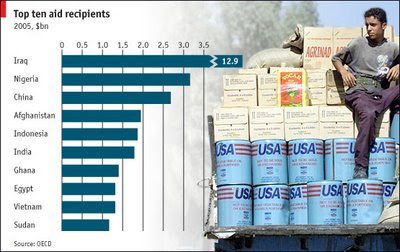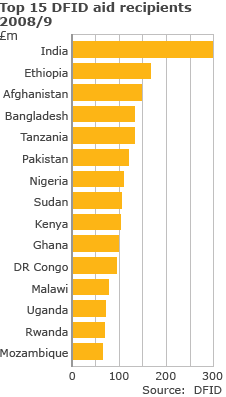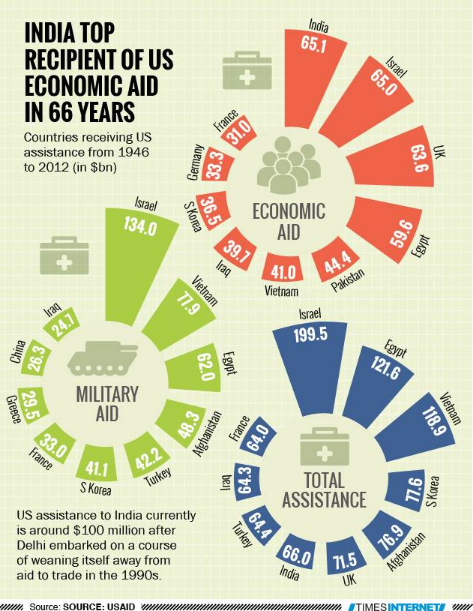PakAlumni Worldwide: The Global Social Network
The Global Social Network
Foreign Aid to India
India was the fourth largest recipient of aid (ODA) between 1995 to 2008 (US$26.1 billion), according to Global Humanitarian Assistance website.
According to OECD group of the aid donor nations, the words "aid" and "assistance" refer to flows which qualify as Official Development Assistance (ODA) or Official Aid (OA). Such OA or ODA aid includes both grants and soft loans given by OECD nations and multi-lateral institutions like the World Bank, Asian Development Bank, IMF, etc.

Britain will spend over $1.5 billion during the next three years in aid to Shining India, a nuclear-armed power that sent a spacecraft to the moon recently, to lift "hundreds of millions of people" out of poverty, the British secretary of state for international development said last November, according to the Guardian newspaper.
Douglas Alexander, the first cabinet minister to visit India's poorest state Bihar, said that despite "real strides in economic growth" there were still 828 million people living on less than $2 a day in India.
UK's Department of International Development says if the UN's millennium development goals - alleviating extreme poverty, reducing child mortality rates and fighting epidemics such as Aids - are left unmet in India, they will not be met worldwide. Some 43% of children go hungry and a woman dies in childbirth every five minutes.
British Minister Alexander contrasted the rapid growth in China with India's economic success - highlighting government figures that showed the number of poor people had dropped in the one-party communist state by 70% since 1990 but had risen in the world's biggest democracy by 5%.

After the increase of British aid to $500 million (300 million pounds) a year, India will still remain the biggest recipient of Japan's official development assistance (ODA) in the near future. Since Japan's first ODA to India in 1958, the country has received monetary aid worth Rs 89,500 crore (Rs 895 billion) so far, according to Noro Motoyoshi, Japanese consul general in Kolkata. In 2008, Japan's ODA to India was up by more than 18% compared to 2007 at Rs 6916 crore (Rs 69.16 billion).
The World Bank said recently it will lend India $14 billion in soft loans by 2012 to help the country overhaul its creaking infrastructure and increase living standards in its poor states, according to Financial Express.
At the recent G20 meeting, India has asked the World Bank to raise the amount of money India can borrow as soft loans, generally considered aid, from the bank for its infrastructure projects, according to Times of India. At present, India can borrow up to $15.5 billion in soft loans as per the SBL (single borrower limit)in soft loans fixed by the Bank.
The Indian government has estimated it needs $500 billion over the five years to 2012 to upgrade infrastructure such as roads, ports, power and railways.
"Under the strategy, the bank will use lending, dialogue, analytical work, engagement with the private sector, and capacity building to help India achieve its goals," the World Bank said on its website.
The International Bank for Reconstruction and Development would lend $9.6 billion and the International Development Association would make available $4.4 billion of funding, according to India's Financial Express.
Only 30 per cent of India's state highways have two lanes or more, and the majority are in poor condition, the bank said. Electricity generation capacity has grown at less than 5 per cent in the past five years, much slower than overall economic growth of about 8 per cent over the same period.
The funds would also be used to help reduce poverty in seven low-income states; Bihar, Chhatisgarh, Jharkand, Madhya Pradesh, Orissa, Rajasthan and Uttar Pradesh, the World Bank said.
 |
| Foreign Aid as Percentage of Indian GDP. Source: World Bank |
The biggest direct aid donor countries to India are Japan and UK, as well as multiple international humanitarian aid programs supported through NGOs, in addition to the World Bank, UNICEF, UNESCO, UNDP, WFP, and a whole alphabet soup of organizations active in helping the teeming population of the poor, the illiterates, the hungry and and the destitute in India.
According to Japan's ministry of finance, India has received $33 billion in soft loans and a billion dollars in grants from Japan since 1997. In 2008, Japan gave India $2.5 billion in soft loans, and $5 million in grants. By contrast, Pakistan has received $10 billion in soft loans, and $2.3 billion in grants from Japan since 1999. In 2008, Japan gave Pakistan $500 million in soft loans and $63 million in grants.
 |
| India Top Recipient of US Economic Aid Source: Times of India |
There is widespread hunger and malnutrition in all parts of India. India ranks 66th on the 2008 Global Hunger Index of 88 countries while Pakistan is slightly better at 61 and Bangladesh slightly worse at 70.
Indian media's headlines about the newly-minted Indian billionaires need to bring sharper focus on the growing rich-poor gap in India. On its inside pages, The Times of India last year reported Communist Party leader Sitaram Yechury's as saying that "on the one hand, 36 Indian billionaires constituted 25% of India’s GDP while on the other, 70% of Indians had to do with Rs 20 a day". "A farmer commits suicide every 30 minutes. The gap between the two Indias is widening," he said. Over 1500 farmers committed suicide last year in the central state of Chhattisgarh alone.
Among the Asian nations mentioned in an October 2008 UN report, Pakistan is more egalitarian than the India, Bangladesh, China and Indonesia. Based on all the UNDP data, Pakistan does not have the level of hunger and abject poverty observed in India or Bangladesh.
According to the new UN-HABITAT report on the State of the World's Cities 2008/9: Harmonious Cities, China has the highest level of consumption inequality based on Gini Coefficient in the Asia region, higher than Pakistan (0.298), Bangladesh (0.318), India (0.325), and Indonesia (0.343), among others." Gini coefficient is defined as a ratio with values between 0 and 1: A low Gini coefficient indicates more equal income or wealth distribution, while a high Gini coefficient indicates more unequal distribution. 0 corresponds to perfect equality (everyone having exactly the same income) and 1 corresponds to perfect inequality (where one person has all the income, while everyone else has zero income).
Violence is rising in India because of the growing rich-poor gap. Prime Minister Manmohan Singh himself has called the Maoist insurgency emanating from the state of Chhattisgarh the biggest internal security threat to India since independence. The Maoists, however, are confined to rural areas; their bold tactics haven't rattled Indian middle-class confidence in recent years as much as the bomb attacks in major cities have. These attacks are routinely blamed on Muslim militants. How long will Maoists remain confined to the rural areas will depend on the response of the Indian government to the insurgents who exploit huge and growing economic disparities in Indian society.
In 2006 a commission appointed by the government revealed that Muslims in India are worse educated and less likely to find employment than low-caste Hindus. Muslim isolation and despair is compounded by what B. Raman, a hawkish security analyst, was moved after the most recent attacks to describe as the "inherent unfairness of the Indian criminal justice system".
Ironically, there are some parallels here between the violent Maoists movement in India and the Taliban militants in Pakistan, in spite of their diametrically opposed ideologies. Maoists say they are fighting for the rights of neglected tribal people and landless farmers, as are the Taliban in FATA and NWFP. Though their tactics vary, both movements have killed dozens of people, including security personnel, in the last few weeks. Both movements control wide swathes of territory in their respective countries. Both continue to challenge the writ of central or provincial authorities.
I have always been intrigued by Kerala and I wonder if there is a Kerala model that could be replicated in the rest of South Asia. With the exception of Kerala, the situation in India is far worse than the Human Development Index suggests. According to economist Amartya Sen, who won the Nobel Prize for his work on hunger, India has fared worse than any other country in the world at preventing recurring hunger.
In addition to its high literacy rate, Kerala boasts one of India's best healthcare systems, even for those who can't afford to pay user fees and therefore depend on government hospitals. Kerala's infant mortality rate is about 16 deaths per 1,000 births, or half the national average of 32 deaths per 1,000 births.
Freelance journalist Shirin Shirin thinks Kerala's success has something to do with the fact that communists have ruled Kerala for much of the past 50 years. The CPI(M) successfully pushed for three major reforms in the 1960s and 1970s. The first and most important was land reform. While nearly everyone looks on land reform as a huge success in Kerala, the policy was controversial when it was first proposed in 1959. Land reform, after all, is an attack on one of capitalism's founding principles - the right to property. The central government intervened and effectively blocked the implementation of land reform for 10 years. But planners and unions in Kerala understood that building a more egalitarian economy required attacking the old feudal system at its roots, and small farmers weren't going to stand for anything less.
But even Shining Kerala is plagued by hunger and malnourishment, just as the rest of India. The first India State Hunger Index (Ishi) this year found that Madhya Pradesh had the most severe level of hunger in India, comparable to Chad and Ethiopia. Four states — Punjab, Kerala, Haryana and Assam — fell in the 'serious' category. "Affluent" Gujarat, 13th on the Indian list is below Haiti, ranked 69. The authors said India's poor performance was primarily due to its relatively high levels of child malnutrition and under-nourishment resulting from calorie deficient diets.
A recent issue of San Jose Mercury News has a pictorial about grinding poverty in India done by John Boudreau and Dai Sugano. This heartbreaking pictorial illustrates the extent of the problem that India faces, a problem that could potentially be very destabilizing and put the entire society at the risk of widespread chaos and violence.
https://youtu.be/84-Qz4vFVHs
Related Links:
Aid at a Glance by OECD Nations
Economic Woes? Look to Kerala
Mumbai's Slumdog Millionaire
Poverty Tours in India, Brazil and South Africa
South Asia's War on Hunger Takes Back Seat
Grinding Poverty in Resurgent India
Pakistani Children's Plight
Japans's Aid to India
Poverty in Pakistan
Japan's ODA to Pakistan
OECD's Definition of Aid
-
Comment by Riaz Haq on August 11, 2017 at 8:31am
-
#NBA’s #KevinDurant on #India"Cows, Stray Dogs" "Bunch of Underprivileged People" "20 years behind" #Poverty #Filth
https://www.thequint.com/sports/2017/08/11/nba-star-kevin-durant-on...
NBA champion Kevin Durant of the Golden State Warriors had visited India in July to help the NBA make inroads into the nation of 1.3 billion.
Durant took part in a camp in New Delhi, where he helped set a Guinness World Record for the largest basketball lesson – 3,459 people participated in it across multiple venues.
The NBA finals MVP met young players at the NBA Academy, with many more joining via satellite from four other cities across the country.
However, after returning to the United States, he said in an interview to The Athletic that India is 20 years behind in terms of knowledge and experience.
I went with no expectation, no view on what it’s supposed to be like. I usually go to places where I at least have a view in my head. India, I’m thinking I’m going to be around palaces and royalty and gold — basically thought I was going to Dubai. Then when I landed there, I saw the culture and how they live and it was rough. It’s a country that’s 20 years behind in terms of knowledge and experience.
Kevin Durant
Durant added that there are “just a bunch of underprivileged people living in India”.
You see cows on the street, monkeys running around everywhere, hundreds of people on the side of the road, a million cars and no traffic violations. Just a bunch of underprivileged people there and they want to learn how to play basketball. That was really, really dope to me.
-
Comment by Riaz Haq on May 16, 2020 at 5:35pm
-
India is world's no-1 recipient of foreign aid money.
https://www.wristband.com/content/which-countries-provide-receive-m...
Top 10 Recipients of Foreign Aid From DAC Members
India: $4.21 billion
Turkey: $4.10 billion
Afghanistan: $2.95 billion
Syria: $2.77 billion
Ethiopia: $1.94 billion
Bangladesh: $1.81 billion
Morocco: $1.74 billion
Vietnam: $1.61 billion
Iraq: $1.60 billion
Indonesia: $1.48 billion
-
Comment by Riaz Haq on May 16, 2020 at 5:45pm
-
#Modi's #India Top Recipient of Foreign Aid; #Pakistan Not Even in Top 15.
https://twitter.com/haqsmusings/status/1261819219890429952?s=20
India is world's no-1 recipient of foreign aid money.
https://www.wristband.com/content/which-countries-provide-receive-m...
Top 10 Recipients of Foreign Aid From DAC Members
India: $4.21 billion
Turkey: $4.10 billion
Afghanistan: $2.95 billion
Syria: $2.77 billion
Ethiopia: $1.94 billion
Bangladesh: $1.81 billion
Morocco: $1.74 billion
Vietnam: $1.61 billion
Iraq: $1.60 billion
Indonesia: $1.48 billion
-
Comment by Riaz Haq on March 13, 2023 at 5:26pm
-
#UK #aid to #India does little for #humanrights and #democracy, watchdog finds. Aid Program spent £2.7bn between 2016 and 2021 but is fragmented and lacks a clear rationale. There's no programming related to democratic space, free media or human rights https://www.theguardian.com/global-development/2023/mar/14/uk-aid-i...
Britain’s aid programme to India is fragmented, lacks a clear rationale and does little to counter the negative trends in human rights and democracy in the country, the government’s aid watchdog has found.
The findings are likely to be used by those who claim the UK government risks using its aid programme to deepen its relationship with India, including seeking free trade deals, rather than attempting to reduce poverty, which is the statutory purpose of UK aid.
The review by the Independent Commission for Aid Impact said the government spent £2.7bn on aid to India between 2016 and 2021, including the provision of loans by the government-run British International Investment to mainly smaller companies. In total, loans to India represent 28% of the BII global loan portfolio.
The review finds “the overall programme is fragmented across activities and spending channels and lacks a compelling development rationale”, particularly since India already has relatively developed financial markets.
The UK does not use its aid programme, enshrined in a joint roadmap signed by India and the UK in 2021, to support Indian democracy and human rights, despite backsliding in this area under the premiership of Narendra Modi, the review says.
The ICAI review group reported: “To explain the limited activity on democracy and human rights, Foreign Office officials noted India’s acute sensitivity to any external influence in its political affairs, particularly from the UK. They acknowledged that the UK and India have different perspectives in this area and described the roadmap as being based on shared interests, rather than shared values. They informed us that the UK engages in ‘quiet diplomacy’ on issues such as freedom of speech.”
On human rights the report finds the 2021 roadmap setting out India and the UK’s joint cooperation goals “does not include any objectives related to the promotion of democracy or human rights in India” and adds that “the UK has not been particularly active in India in this area in recent years, either in its aid programme or in its public diplomacy”.
Comment
Twitter Feed
Live Traffic Feed
Sponsored Links
South Asia Investor Review
Investor Information Blog
Haq's Musings
Riaz Haq's Current Affairs Blog
Please Bookmark This Page!
Blog Posts
PIA Privatization: Can it Bring Back Pakistan National Airline's Glory Days?
After decades of failed attempts, the Government of Pakistan has finally privatized the Pakistan International Airline (PIA) under intense pressure from the International Monetary Fund (IMF). Nonetheless, it is a deal that will give the national airline not only a chance to survive but to thrive in the long run. As part of structuring the sale for Rs. 135 billion, the government has assumed Rs. 654…
ContinuePosted by Riaz Haq on December 25, 2025 at 10:30am — 5 Comments
Pakistan Pharma Begins Domestic Production of GLP-1 Weight Loss Drugs
Several Pakistani pharmaceutical companies have started domestic production of generic versions of GLP-1 (Glucagon-Like Peptide-1) drugs Ozempic/Wegovy (Semaglutide) and Mounjaro/Zeptide (Tirzepatide). Priced significantly lower than the branded imports, these domestically manufactured generic drugs will increase Pakistanis' access and affordability to address the obesity crisis in the country, resulting in lower disease burdens and improved life quality and longer life expectancy. Obesity…
ContinuePosted by Riaz Haq on December 19, 2025 at 10:00am — 4 Comments
© 2025 Created by Riaz Haq.
Powered by
![]()
You need to be a member of PakAlumni Worldwide: The Global Social Network to add comments!
Join PakAlumni Worldwide: The Global Social Network